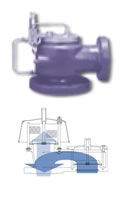Pilot Operated Relief Valve
The Pilot Operated Relief Valve also called Pilot Operated Safety Valve, POPRV (Pilot Operated Pressure Relief Valve), or POSRV (Pilot Operated Safety Relief Valve), depending on the manufacturer and the application. Technically POPRV is the most generic term, but PORV is often used generically (as in this article) even though it should refer to valves in liquid service.
The Motherwell Tank Protection range of Pilot Operated Relief Valves are pressure relief only valves. All combinations of valves are available in a range of sizes from 50mm (2″) to 300mm (12″) and with flanged outlets or vented to atmosphere.
- provide accurate pressure relief when operating near to the design pressure of the tank
- overcome the problems of back pressure generated at the discharge of the valve due to pipework, scrubbers etc.
The Pilot Operated Relief Valve is available in a range of sizes and flange configurations and are certified compliant with European ATEX and PED directives where applicable.
The Pilot Operated Relief Valve features can be summarised below:
Advantages of Pilot Valve:
- Smaller package on the larger pipe sizes.
- More options for control.
- Seals more tightly as the system pressure approaches but does not reach set pressure.
- Control pilot can be mounted remotely.
- Some designs allow for changes in orifice size within the main valve.
Disadvantages of Pilot Valve:
- More complex than conventional Breather Valves.
- More expensive at smaller size valves (starts to even out as size increases).
- Small parts in pilot valves are sensitive to contaminant particles